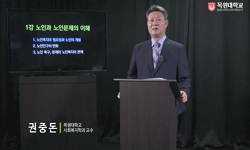This article, analysed and organized legal principles and practical issues of the peak wage system and a various theory of interpretation related to the extending retirement age which was established at age of 60 in 2013 and ahead of the implementatio...
http://chineseinput.net/에서 pinyin(병음)방식으로 중국어를 변환할 수 있습니다.
변환된 중국어를 복사하여 사용하시면 됩니다.
- 中文 을 입력하시려면 zhongwen을 입력하시고 space를누르시면됩니다.
- 北京 을 입력하시려면 beijing을 입력하시고 space를 누르시면 됩니다.

정년연장과 임금피크제 = The analysed and organized legal principles and practical issues of the peak wage system and a various theory of interpretation related to the retirement age
한글로보기부가정보
다국어 초록 (Multilingual Abstract)
In addition the tripartite should all be able to get all the original effects to expect when it is consisted of relations with working conditions and working techniques when introducing the peak wage system.
This article, analysed and organized legal principles and practical issues of the peak wage system and a various theory of interpretation related to the extending retirement age which was established at age of 60 in 2013 and ahead of the implementation of it in 2016. While extending retirement age is the mandatory, the wage system reform is a deficiency of rule of law that is proclamatory rule lacking forcibleness. There are various types in peak wage system, but it can generally be categorized by retirement age guaranteed type and prolonged retirement age type(prolonged employment type). As for the contents of these peak wage system, it was specifically reviewed the strengths and weaknesses of the system in relation with the labor law. The Ministry of Employment and Labor insist with expectation that introducing the peak wage system would be able to achieve wage adjustment, continuous job security in the middle aged and the elderly and job creation in the youth. The peak wage system could be a resolving method in the seniority based wage system, as the extension of the retirement age can be a burden of cost for a company, however the peak wage system may cause conflict between labor and management because it is closely related to the lives of their families for workers. This series of current situation was explained for a background of the introduction of the peak wage system. The company is specifically introducing retirement wage guaranteed type under this circumstance that the retirement age has been extended by law. In the point of view of labor law, retirement age guaranteed type peak wage system eventually means the problem of adverse changes in the working conditions and is not a separate independent wage system. Therefore if you want to introduce a retirement age guaranteed peak wage system it requires a majority union or a majority of workers agreement. In addition, when introduced into a collective agreement it should be viewed as comprising an agreement for disadvantageous revision of rules of employment. Also the peak wage system corresponds to an age discrimination as it still prohibits wage cuts in respect to the elderly age discrimination law. Our companies’ peak wage system practices are unlike in the case of Japan, being introduced as part of the company personnel structure adjustment as it is overlapping with redundancy in a functional perspective. Therefore the peak wage system should meet the procedural requirements of layoffs, and it is invalid to apply application of the principle of changing circumstances recognizing layoffs after job security agreement.
In addition the tripartite should all be able to get all the original effects to expect when it is consisted of relations with working conditions and working techniques when introducing the peak wage system.
참고문헌 (Reference)
1 안주엽, "합리적 정년연장과 정책과제" 한국고용노사관계학회 24 (24): 87-108, 2014
2 "한국노동조합총연맹"
3 "한국노동연구원"
4 "한국경영자총협회"
5 "취업포털 잡코리아"
6 이규용, "중소기업 빈 일자리 채우기 및 일자리 나누기 사업의 성과평가" 한국노동연구원 1 (1): 2006
7 조용만, "정년연장의 법적 과제" 한국노동연구원 12 (12): 1-23, 2012
8 권혁, "정년연장에 따른 임금체계개편과 취업규칙 변경법리" 2015
9 이정, "정년연장에 따른 노동법상의 쟁점과 과제" 한국고용노사관계학회 24 (24): 21-45, 2014
10 국제전략 문제연구소, "정년연장법의 대응" 2013
1 안주엽, "합리적 정년연장과 정책과제" 한국고용노사관계학회 24 (24): 87-108, 2014
2 "한국노동조합총연맹"
3 "한국노동연구원"
4 "한국경영자총협회"
5 "취업포털 잡코리아"
6 이규용, "중소기업 빈 일자리 채우기 및 일자리 나누기 사업의 성과평가" 한국노동연구원 1 (1): 2006
7 조용만, "정년연장의 법적 과제" 한국노동연구원 12 (12): 1-23, 2012
8 권혁, "정년연장에 따른 임금체계개편과 취업규칙 변경법리" 2015
9 이정, "정년연장에 따른 노동법상의 쟁점과 과제" 한국고용노사관계학회 24 (24): 21-45, 2014
10 국제전략 문제연구소, "정년연장법의 대응" 2013
11 이철수, "정년 60세 시대: 법률적 쟁점과 기업의 인사노무관리 전략" 2014
12 이지만, "정년 60세 법안 안착을 위한 임금과 (중장년)인력관리정책" 2012
13 방하남, "점진적퇴직제도와 부분연금제도 연구" 한국노동연구원 2012
14 고용노동부, "장년고용연장지원금"
15 박종희, "임금피크제의 허와 실 - 노동법적 검토 및 정책적 평가를 중심으로 -" 한국고용노사관계학회 14 (14): 23-46, 2004
16 한국노동연구원, "임금피크제에 대한 연구" 2006
17 박종희, "임금피크제에 대한 법적 검토 및 정책적 제언" 고용노동부/뉴패러다임센터 2006
18 변상우, "임금피크제 정착방안에 관한 연구" 한국인적자원관리학회 12 (12): 47-60, 2005
19 김정한, "임금피크제 실태조사" 고용노동부 2008
20 고용노동부, "임금피크제 도입현황 및 효과분석"
21 김정한, "임금피크제 도입방안" 한국노동연구원 2012
22 김정한, "임금피크제 도입방안" 한국노동연구원 2004
23 이희성, "임금피크제 도입과 문제점에 관한 법정책적 고찰" 한국법정책학회 (2(6)) : 603-623, 2006
24 정숙희, "임금피크제 도입 사례와 실무자 유의사항" 중앙경제사 2015
25 이지만, "임금피크제 국내외 도입사례 및 효과분석" 고용노동부/뉴패러다임센터 2006
26 고용노동부, "임금체계 개편 사례집"
27 박지순, "임금·근로시간·정년에 관한 쟁점의 노동법적 해결방안" 2014
28 김명중, "일본의 정년제와 최근의 동향" 한국노동연구원 2010
29 송민수, "일본기업의 사례" 한국노동연구원 2012
30 안희탁, "일본기업의 고령자 고용과 임금피크제" 경총 임금연구센터 2004
31 신석호, "일본과 한국의 임금피크제 사례분석"
32 대한상공 회의소, "일본과 한국의 임금피크제 사례보고서" 2003
33 "유럽연합"
34 박성준, "우리나라 임금피크제의 현황과 문제점에 관한 연구" 한국인적자원관리학회 16 (16): 85-100, 2009
35 "선택한 내용을저자(1)공동저자(2)공동저자+(3)제목"
36 "서울지법 2008.8.1, 선고 2007가합111716 판결"
37 "서울고법 2009. 1. 9 선고 2008누17877 판결"
38 "서울고법 2001.5.30, 2000누7300 판결"
39 "서울고법 2001. 4. 11 선고 2000나15908 판결"
40 "서울고법 2000. 11. 16, 선고 2000누5694 판결"
41 "매일노동뉴스"
42 "대법원 2014. 3. 27, 선고 2011두20406 판결"
43 "대법원 2011. 9. 8, 선고 2011다22061 판결"
44 "대법원 2011. 7. 28, 선고 2009두7790 판결"
45 "대법원 2011. 5. 26, 선고 2011두7526 판결(서울고법 2011. 2. 9, 2010누18552 판결"
46 "대법원 2010. 1. 28, 선고 2009다32362 판결"
47 "대법원 2009. 5. 28, 선고 2009두2238 판결"
48 "대법원 2009. 11. 12, 선고 2009다49377 판결"
49 "대법원 2008. 2. 9, 선고 2007다85997 판결"
50 "대법원 2007. 3. 29, 선고 2004다31302 판"
51 "대법원 2003. 12. 26, 선고 2001두10264 판결"
52 "대법원 2002. 8. 27, 선고 2000두6756 판결"
53 "대법원 2002. 7. 9, 선고 2001다29452 판결"
54 "대법원 2002. 7. 9, 선고 2000두 9373 판결"
55 "대법원 2001. 9. 7, 선고 2000두9977 판결"
56 "대법원 2001. 4. 24, 선고 99다9370 판결"
57 "대법원 1999. 6. 22, 선고 98두6647 판결"
58 "대법원 1996. 8. 29, 선고 95다5783(전원합의체)판결"
59 "대법원 1995. 3. 10, 선고 94다18072 판결"
60 "대법원 1994. 12. 23, 선고 94누3001 판결"
61 "대법원 1993. 12. 28, 선고 92다34858 판결"
62 "대법원 1992. 12. 22, 선고 91다45165 판결"
63 "대법원 1991.9. 24, 선고 91다17542 판결"
64 "대법원 1991.4. 9, 선고 90다16245 판결"
65 "대법원 1991.3. 27, 선고 91다3031 판결"
66 "대법원 1989.7. 11, 선고 88다카21296 판결"
67 "대법원 1978.9. 12, 선고 78다1046 판결"
68 경제사회 발전노사정위원회, "노동시장 구조개선을 위한 사회적 대화 진단과 대안"
69 "노동부 근기 68207-890"
70 이원희, "노동법의 쟁점과 과제(김유성교수 회갑기념논문집)" 2000
71 김유성, "노동법 I" 2006
72 임종률, "노동법" 博英社 2006
73 임종률, "노동법" 博英社 2006
74 이병태, "노동법" 2002
75 김형배, "노동법" 2006
76 "기획재정부"
77 방하남, "기업의 정년실태와 퇴직 관리에 관한 연구" 한국노동연구원 2012
78 박종희, "기업내 근로조건 결정 메카니즘, 취업규칙 제도와 관련하여" 한국노동연구원 2006
79 하갑래, "근로자 동의 없는 임금체계개편은 불가능" 중앙경제사 2015
80 "근로기준과-4174"
81 "국회 전자도서관"
82 "국민연금관리공단"
83 조용만, "국가인권위원회 고용차별시정 10년 사례의 분석" 한국노동연구원 12 (12): 87-113, 2012
84 "고용노동부"
85 이지만, "고령화친화적 기업경영모델 개발 및 확산에 관한 연구" 보건복지부 2006
86 박준성, "고령화시대의 인적자원관리와 정년제" 고용노동부 2006
87 홍길표, "고령화 시대에 따른 기업의 인적자원전략 리포트" 한국인력개발학회 2008
88 박종희, "고령화 사회에서의 노동법적 과제― 정년제 및 고령자 고용과 관련하여 ―" 한국노동법학회 (20) : 113-160, 2005
89 한국노동연구원, "고령화 사회에 대한 대책" 2003
90 이철수, "고령자 고용과 정년제의 법적 과제" 법제연구원 2014
91 蛯原典子, "高齡者の生活と法" 有斐閣 1999
92 박준성, "POSCO의 정년연장형 임금피크제 사례" 한국고용노사관계학회 22 (22): 1-29, 2012
93 하갑래, "60세 정년제와 임금체계 개편 관련 법적 쟁점사항 연구" 고용노동부 83-, 2013
94 고용노동부, "60세 정년제 정착지원 기본계획(안)" 2013
동일학술지(권/호) 다른 논문
-
- 노동법이론실무학회
- 권혁
- 2015
- KCI등재
-
- 노동법이론실무학회
- 전혜향
- 2015
- KCI등재
-
- 노동법이론실무학회
- 전윤구
- 2015
- KCI등재
-
- 노동법이론실무학회
- 강선희
- 2015
- KCI등재
분석정보
인용정보 인용지수 설명보기
학술지 이력
| 연월일 | 이력구분 | 이력상세 | 등재구분 |
|---|---|---|---|
| 2026 | 평가예정 | 재인증평가 신청대상 (재인증) | |
| 2020-01-01 | 평가 | 등재학술지 유지 (재인증) |  |
| 2017-01-01 | 평가 | 등재학술지 유지 (계속평가) |  |
| 2014-01-01 | 평가 | 등재학술지 선정 (계속평가) |  |
| 2013-01-01 | 평가 | 등재후보 1차 PASS (등재후보1차) |  |
| 2011-01-01 | 평가 | 등재후보학술지 선정 (신규평가) |  |
학술지 인용정보
| 기준연도 | WOS-KCI 통합IF(2년) | KCIF(2년) | KCIF(3년) |
|---|---|---|---|
| 2016 | 0.64 | 0.64 | 0.58 |
| KCIF(4년) | KCIF(5년) | 중심성지수(3년) | 즉시성지수 |
| 0.61 | 0.56 | 0.832 | 0.35 |




 DBpia
DBpia






